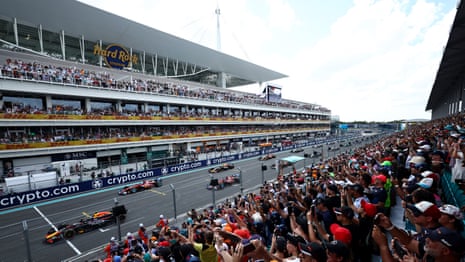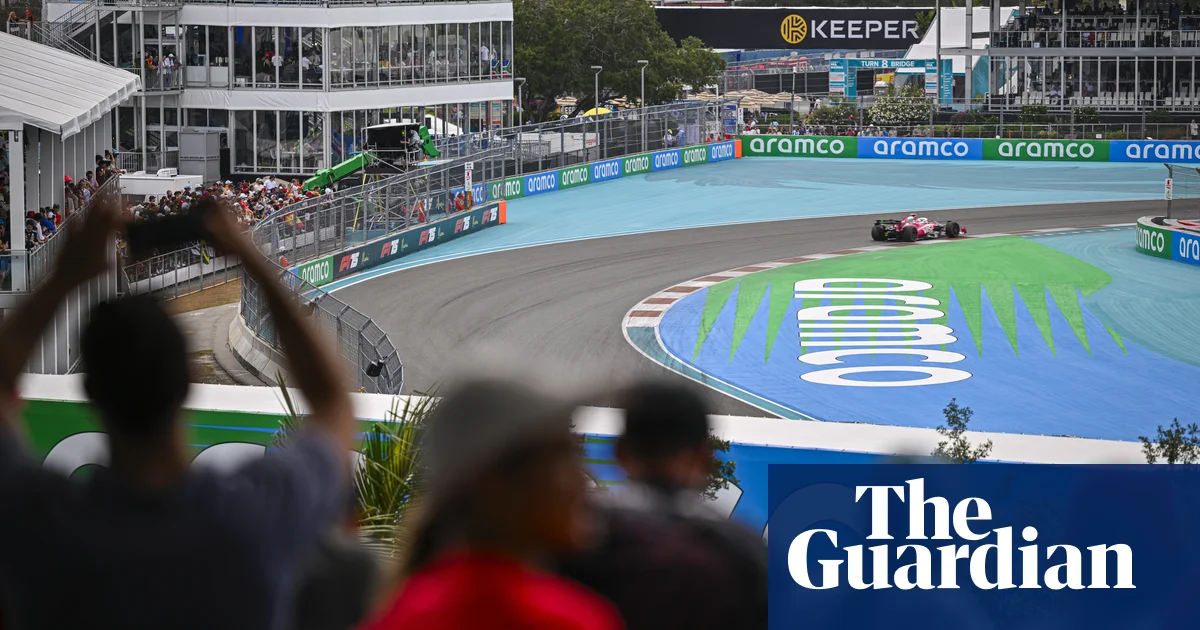On a humid Sunday afternoon in 2022, a who’s who of Hollywood’s rolling credits, Silicon Valley tech tycoons and the internet’s favorite micro-celebrities sat comfortably in shaded trackside VIP suites as 20 cars jolted past. Formula One, America’s latest sporting obsession, had finally carved out a home in South Florida and it fit Miami’s over-the-top image.
Four years into F1’s 20-year stay in the 305, the event has solidified itself as a place to see and be seen: everyone from Kardashians to A-list actors to sports stars has lined up for a joy ride around the turquoise circuit’s 19 corners.
This Sunday’s race will be no different. But a few hundred feet outside Hard Rock Stadium’s walls sits a different side of Miami, one that isn’t even within city limits. And Hard Rock’s history is an example of how much stadiums can have an effect on the people who live near them in the US.
Miami Gardens, 16 miles north of downtown Miami, is a thriving African-American city – an economic haven for Black Miamians forced out of other neighborhoods as Miami built up and out. In Miami Gardens, households, on average, bring in $60,000 a year and more than 13% of the city’s 110,000 people live in poverty. About 70% of residents are Black, according to the US Census Bureau.
So when Joe Robbie, the founder of the Miami Dolphins, drew up plans for a stadium in the center of Miami Gardens in 1985 after downtown Miami raised the team’s rent, locals feared they would be pushed out of Miami Gardens. Then F1 came knocking on residents’ doors nearly 35 years later, setting up a race track attached to Hard Rock Stadium in the center of Miami Gardens. Locals uncapped sharpies and took to the streets with signs reading “Formula One ‘Millions,’ Our Health ‘Priceless’”.
While residents may not position themselves outside the stadium this Sunday, concerns never entirely ceased.
F1’s move to Miami Gardens followed a pattern: events that whiter and wealthier neighborhoods opposed – like the world’s largest hip-hop festival – ended up at Hard Rock Stadium.
The Miami Grand Prix is just the latest example. F1 proposed a race in downtown Miami in 2018, just as the sport began to swell stateside. Residents in a majority-white neighborhood filed a cease-and-desist order citing traffic and noise concerns. The potential for an F1 grand prix down Biscayne Boulevard was quickly squashed by the city council. Organizers pivoted their sights to Miami Gardens, the largest predominantly Black neighborhood in Florida.
Treating working class, historically redlined communities as a dumping ground for undesirable spectacles is routine across the US and is “the path of least resistance”, Timothy Kellison, an associate professor at Florida State University who centers his research on how stadiums exacerbate environmental inequalities, said. “The decision doesn’t escape me that [the Miami GP] was proposed downtown and they said, ‘No, this will be too much disruption.’”
Residents with addresses lining the stadium sued then-Miami-Dade County mayor Carlos Giménez, F1, Hard Rock Stadium and the Miami Dolphins for racial discrimination. Neighbors of Hard Rock Stadium, led by former county commissioners Betty Ferguson and Barbara Jordan, raised similar arguments as downtown Miami homeowners, including traffic and public health concerns. “We really believe it’s environmental racism,” Ferguson said at the time.
But after failing to prove racially motivated malice, noise pollution was the smoking gun that never quite fired. Residents dropped their second lawsuit after their data didn’t point toward evidence that the GP could lead to hearing loss. The judge ruled that any potential harm was “speculative” and “avoidable”. He recommended locals who had concerns stay inside their homes and wear earplugs.
The Miami GP’s promoter, South Florida Motorsports, has measured air quality and noise across the circuit’s campus each year. The results show that noise and air pollution from 2022 to 2024 passed EPA and OSHA industry standards. “The air pollution figures are actually lower following the Miami GP than other events because we provide so many alternate transportation and ride-share options to reduce cars on the local roads,” a race spokesperson said.
“That doesn’t mean that therefore there is no effect because they were unable to show noise pollution,” Kellison says.
Despite locals saying they would continue to work within the political system for justice, the protests stopped. Facebook groups, like Miami Gardens Families Unite, haven’t posted since the inaugural grand prix. The Guardian spoke to a number of people who said they oppose the race, but none were willing to go on record. Equally, others say they are unbothered by, or support, the race.
“The political system is probably not in [people who oppose the GP’s] favor right now,” Madeleine Orr, a sport ecologist who founded the Sport Ecology Group with Kellison, said.
Over the past two years, Miami mayor Francis Suarez garnered backlash for attending the Miami GP, once with Florida’s wealthiest man and a second time with his private equity firm. Some of the same county commissioners who voted against F1’s presence in the community officially declared 4 May “Formula One Day” last year. One of those elected officials included Oliver Gilbert who, in 2019, said: “It’s not a place to dump events that are toxic to people.”

Formula 1 has announced that the Miami Grand Prix will remain on the calendar through 2041, following a 10-year extension to its existing agreement with the promoter South Florida Motorsports. Photograph: Jared C Tilton/Formula 1/Getty Images
It should be pointed out that even without the Miami GP, Hard Rock Stadium would still affect Miami Gardens. The jury is still out on how US sports stadiums, most of which are in cities, affect their surrounding neighborhoods.
Supporters make the economic impact argument: stadiums funnel money into the local community through job creation and tax revenue boosts, along with transforming cities into more livable and desirable spaces by bringing more efficient buildings and natural disaster prevention to neighborhoods. Hard Rock Stadium is a top employer in the city and the 2025 F1 race will credential 18,000 people, the majority from Miami Gardens, to work the event. Fifteen locally owned restaurants will partner with the track. The first three years brought more than $1bn in economic impact and boosted bottom lines for the sport – the 2024 Miami race shattered F1’s viewership record.
The F1 ruling body’s current environmental standards do not require circuits to think about a race’s impact on host communities, Orr said. However, she believes the sport is working in good faith to consider how its presence could affect locals. Orr will join the Federation Internationale de l’Automobile (FIA) University as a visiting sustainability professor this year.
There have been efforts to make sure the race benefits the local community. Before Hard Rock started hosting the grand prix, the stadium and the event promoter outlined a set of conditions with the Miami-Dade County Commission. The Community Benefits Agreement requires F1 to host the race “in a manner that provides substantial economic and community benefits that directly support city residents and locally-owned businesses to participate in the event and promote the city as the first majority African-American city to host a Formula 1 race.” That means providing $5m in community funding and committing to noise mitigation, air quality monitoring and racing outside of school hours. “F1 in Schools” included opening the sport’s paddock to local students and interns for STEM programming.
Since the document was drawn up in 2021, the partnership has settled into a rhythm of community engagement: hosting a “Business of F1 Community Workshop,” creating scholarships for students at Miami Gardens’ two local universities, handing out 1,500 free tickets per year for residents and diverting food waste to local food banks. The stadium lessened traffic concerns with a $17m investment in tunnels and pedestrian bridges.
Since the stadium moved to Miami Gardens, it has allocated a portion of parking revenues to a local neighborhood association.
Ray Reyno, a Miami Gardens resident who moved to the area before the stadium was built, doesn’t mind the noise, claiming it could be worse, and focuses instead on the benefits the stadium has brought to the community. “It’s not like the [engines] that used to be loud,” Reyno said. “It’s not that loud.”
Orr says bringing a grand prix to a city raises questions. “If we come to this place, we are going to necessarily have a carbon footprint,” she says. “But what are the exchanges we can have with the community? What kinds of tech transfer can we bring and then leave here? What kinds of solutions can be implemented at this place?”
But not everyone was convinced by the Community Benefits Agreement. Kellison says some questioned whether the agreement was “enough to compensate for the disruption that [the race] is going to cause, environmentally, economically, just quality of life for a weekend.” Two county commissioners voted against the agreement.
And those objections raise wider issues about stadiums, not just those that host F1 races. Critics claim they often exacerbate environmental and social inequality by aggravating air pollution, and limiting access to green space and water – issues that already disproportionately impact neighborhoods of color (across the US, predominantly Black zip codes tend to be more polluted and hotter on average than other areas). Miami Gardens residents argued F1’s presence would amplify these issues.
Even before the starting lights go out on Sunday afternoon and engines screech to life, locals will feel F1’s presence. For some, like Reyno, the stadium’s community efforts have righted its reputation. “I admire what they’re doing,” he says. “Makes the place more alive.”
Orr is more circumspect. “Even given what I know and who I work with, I will probably side with residents on this,” she says. “I don’t know that I would want it in my backyard.”
Kellison, who wrote and edited a book about the topic, draws a blank when it comes to the ideal place for a stadium. “I’ve been thinking about this for as long as I’ve been studying sport, and I don’t have an answer,” he said. Some locals proposed that the GP take place 47 miles south, at the Homestead-Miami Speedway. But residents there have also raised noise and public health concerns.
“I think it’s important to recognize the fact that this is not just an isolated group of naysayers who are ‘not my backyard’ people and would oppose everything,” Kellison says. “If they’ve been talking about events at the stadium or around the stadium site for a number of years, a number of decades, perhaps they’re on to something.”
Calling in from his office on Florida State University’s campus, Kellison pauses and recalls a line he read once that stuck with him: “Race tracks aren’t meant to be in neighborhoods.”
